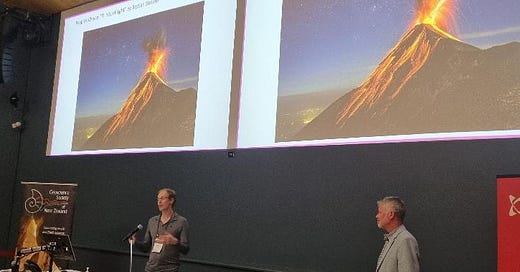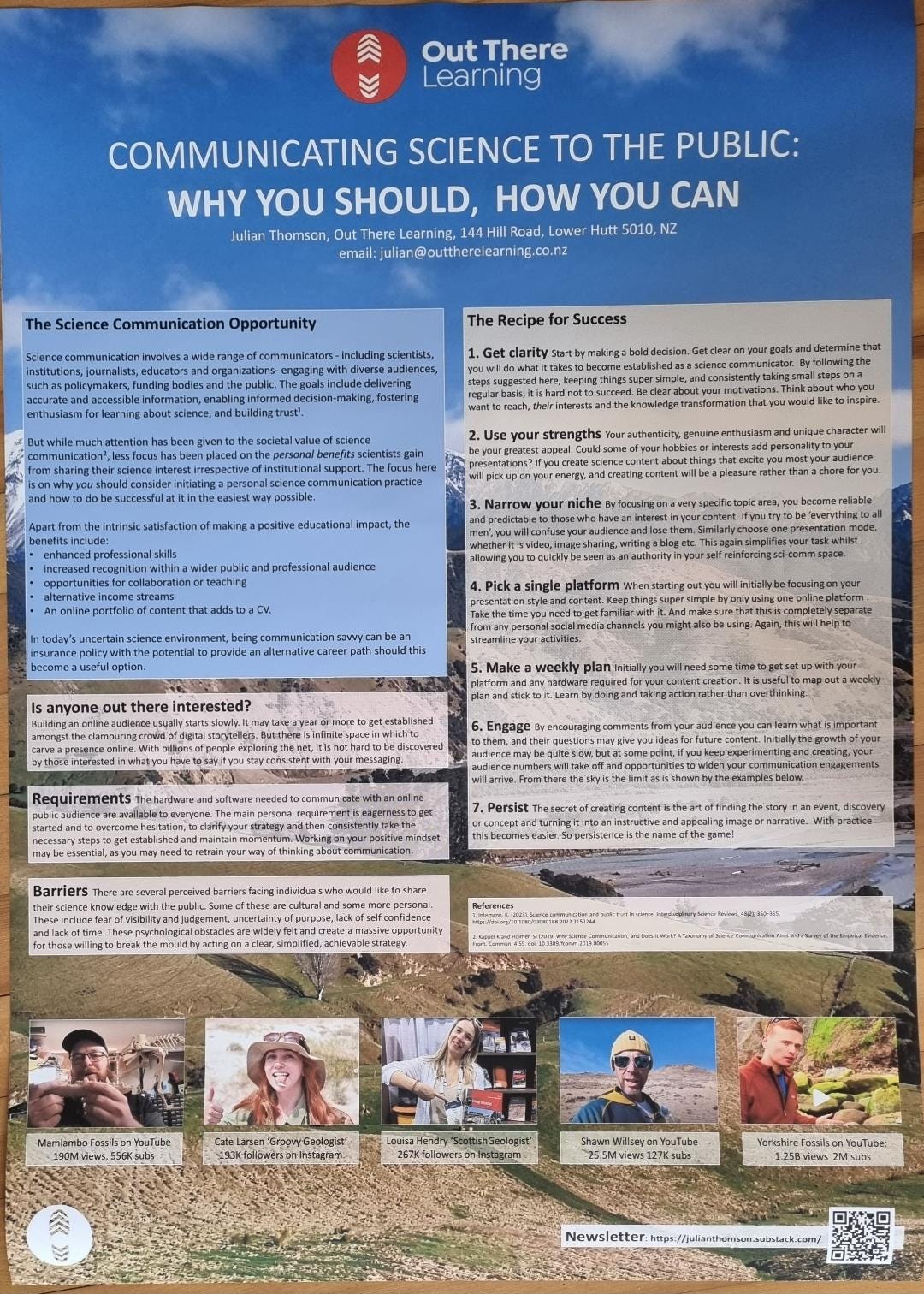Communicating science to the public: Why you should, how you can
The personal benefits of science communication
GSNZ Conference 2024
I have been at the GeoScience Society of New Zealand annual conference this week in Dunedin, and it is great to listen to so many incredible science talks detailing the latest geoscience research going on around the country.
It’s always wonderful to catch up with friends and former colleagues to discuss future opportunities and projects. However, for some people there was a shadow over the conference due to the huge cutbacks that have been inflicted on geoscience research recently, including lots of job losses with a massive impact on the capability of researchers to continue some of their programmes.
A well as talks on many different themes such as earthquake science, volcanic processes, energy and minerals, fossils, Antarctic research etc, there was also a session on science communication and educational outreach. For many years a big issue has been the decreasing uptake of university courses in earth sciences which has been the topic of many discussions on why this is and what to do about it. Part of the solution of course is more and better communication to educators and school students about the significance of geology in our lives and the amazing diverse career paths that a geoscience degree offers.
I presented a poster with the aim of encouraging scientists to consider ramping up their personal science communication activity, and I thought I would copy the text here in case you are interested, so here it is:
The Science Communication Opportunity
Science communication involves a wide range of communicators - including scientists, institutions, journalists, educators and organizations- engaging with diverse audiences, such as policymakers, funding bodies and the public. The goals include delivering accurate and accessible information, enabling informed decision-making, fostering enthusiasm for learning about science, and building trust.
But while much attention has been given to the societal value of science communication, less focus has been placed on the personal benefits scientists gain from sharing their science interest irrespective of institutional support. The focus here is on why you should consider initiating a personal science communication practice and how to do be successful at it in the easiest way possible.
Apart from the intrinsic satisfaction of making a positive educational impact, the benefits include:
•enhanced professional skills
•increased recognition within a wider public and professional audience
•opportunities for collaboration or teaching
•alternative income streams
•An online portfolio of content that adds to a CV.
In today’s uncertain science environment, being communication savvy can be an insurance policy with the potential to provide an alternative career path should this become a useful option.
Is anyone out there interested?
Building an online audience usually starts slowly. It may take a year or more to get established amongst the clamouring crowd of digital storytellers. But there is infinite space in which to carve a presence online. With billions of people exploring the net, it is not hard to be discovered by those interested in what you have to say if you stay consistent with your messaging.
Morne hunts for fossils in New Zealand in his spare time and has made many significant discoveries. He spends many hours preparing his finds and has a very popular YouTube channel with over 550K subscribers.
Requirements
The hardware and software needed to communicate with an online public audience are available to everyone. The main personal requirement is eagerness to get started and to overcome hesitation, to clarify your strategy and then consistently take the necessary steps to get established and maintain momentum. Working on your positive mindset may be essential, as you may need to retrain your way of thinking about communication.
Barriers
There are several perceived barriers facing individuals who would like to share their science knowledge with the public. Some of these are cultural and some more personal. These include fear of visibility and judgement, uncertainty of purpose, lack of self confidence and lack of time. These psychological obstacles are widely felt but create a massive opportunity for those willing to break the mould by acting on a clear, simplified, achievable strategy.
Cate Larsen shares her enthusiasm for geology with her nearly 200K Instagram followers.
The Recipe for Success
1. Get clarity Start by making a bold decision. Get clear on your goals and determine that you will do what it takes to become established as a science communicator. By following the steps suggested here, keeping things super simple, and consistently taking small actions on a regular basis, it is hard not to succeed. Be clear about your motivations. Think about who you want to reach, their interests and the knowledge transformation that you would like to inspire.
2. Use your strengths Your authenticity, genuine enthusiasm and unique character will be your greatest appeal. Could some of your hobbies or interests add character to your presentations? If you create science content about things that excite you most your audience will pick up on your energy, and creating content will be a pleasure rather than a chore for you.
3. Narrow your niche By focusing on a very specific topic area, you become reliable and predictable to those who have an interest in your content. If you try to be ‘everything to all men’, you will confuse your audience and lose them. Similarly choose one presentation mode, whether it is video, image sharing, writing a blog etc. This again simplifies your task whilst allowing you to quickly be seen as an authority in your self-reinforcing sci-comm niche.
4. Pick a single platform When starting out you will initially be focusing on your presentation style and content. Keep things super simple by only using one online platform . Take the time you need to figure out how to use it with ease. And make sure that this is completely separate from any personal social media channels you might also be using. Again, this will help to streamline your activities.
5. Make a weekly plan Initially you will need some time to get set up with your platform and any hardware required for your content creation. It is useful to map out a weekly plan and stick to it. Learn by doing and taking action rather than overthinking.
6. Engage By encouraging comments from your audience you can learn what is important to them, and their questions may give you ideas for future content. Initially the growth of your audience may be quite slow, but at some point, if you keep experimenting and creating, your audience numbers will take off and opportunities to widen your communication engagements will arrive. From there the sky is the limit as shown by the examples below.
7. Persist The secret of creating content is the art of finding the story in an event, discovery or concept and turning it into an instructive and appealing image or narrative. With practice this becomes easier. So persistence is the name of the game!
Photo - Shawn Willsey is geology professor at College of Southern Idaho. he has a popular YouTube channel where he explains geological features and processes in the USA and beyond
Interested in gearing up your science communication? Contact me to learn about my science communication coaching programme or have a look HERE.
Thanks, Julian








